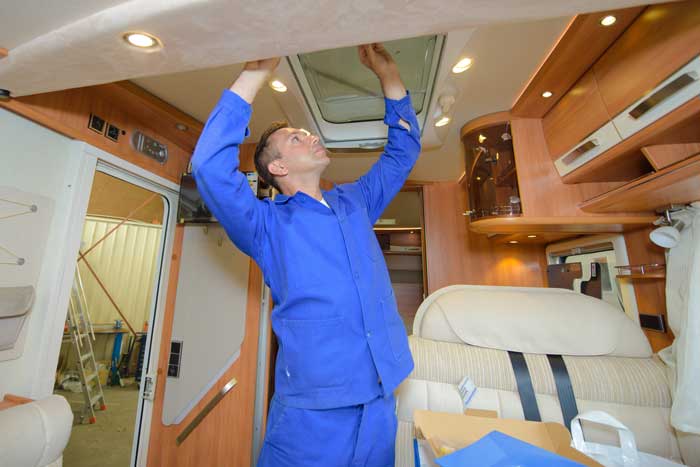 https://auction.ridesafely.com/images/2018/10/banner-truck-auctions-for-everyone.jpg
865
1440
RideSafely
/images/2025/01/ridesafely-logo.svg
RideSafely2025-09-26 12:10:232025-09-26 14:53:10How to Buy Your Next Truck at an Auto Auction
https://auction.ridesafely.com/images/2018/10/banner-truck-auctions-for-everyone.jpg
865
1440
RideSafely
/images/2025/01/ridesafely-logo.svg
RideSafely2025-09-26 12:10:232025-09-26 14:53:10How to Buy Your Next Truck at an Auto AuctionIn our last post we talked about the dreaded problem that is RV water damage. We also discussed how a good deal of water damage may be manageable and worth going through the effort of making repairs.
Once you have identified the extent of water damage and attempted to discover the source, the next step is to begin repairs. Fixing water damage is a very involved process.
It involves several steps, which can be basically broken down as follows:
Get the RV in a covered, dry area for the duration of repairs.

Rain will only worsen your rv water damage problems once you start working your way into the inner structure of the RV, as will ambient moisture.
Pull the RV into a garage or storage unit if you can. If not, a tarp may suffice, but you should place a heat source in the RV on the lowest setting to make sure that humidity does not seep in.
Discover the exact source of the water infiltration.
If the leak comes from equipment, shut the problem equipment off and remove it. If the leak comes from faulty sealant, you will usually not be able to deal with eliminating the source of the leak until the rotted structure has been restored. Just remember to keep this step in mind once you have nearly completed repairs.
Strip away everything that will get in the way of repairs of your rv water damage.
Do not be shy about working your way into the inner structure of the RV. Skimping on the full extent of repairs by working around things like appliances or cabinets will only make the problem more likely to return in the future.
Begin removing the rotted components.
If the water damage is only superficial, you may be able to simply strip the outer layer or sand the surface to get rid of mold and staining. If the rot has worked its way into the paneling, you will have to dispose of the entire panel.
If the rot has worked its way into the structural wood, you will unfortunately have to cut away this rotted wood. Anything that is soft enough to be poked through with a dull knife is rotted to the point that it will only get worse, and it must be removed.
Sometimes, you will have to work all the way down to the outer body paneling. Do not be hesitant to get rid of as much as you possibly can if there is any sign of rot. Just be cautious about the structure collapsing once you start cutting out the integral beams. You may need to put in temporary supports if the weight begins to bear down once the structural wood is removed.
Replace rotted components with new, clean and dry ones.
Now that all of the nasty bits are gone, you can begin putting in fresh ones. You should be able to solidly nail or screw any components together at this point, as the rotted soft pieces will all be gone.
Take measures to protect the replacement wood.
Clean off any areas with disinfectant such as surface sanitizer or bleach to make sure that the mold is completely killed off. If you want to be extra careful or if the surface will be visible, you can coat the wood in a layer of latex primer such as Kilz. This will provide an extra measure of protection from any future moisture or mold growth.
Replace everything back to the way it was supposed to look.
Return all of the gutted and salvageable materials to their proper place. Make sure that everything is solidly nailed back together or screwed in to keep any components from separating once they have been replaced.
Seal every crevasse on the outside of the RV.
Now that you have taken all this time and effort to make these repairs, you want to make certain you do not have to do them again anytime soon. The best way to accomplish this is to ensure that all trim materials are properly secured and all window or structural components are properly bonded.
Finally, make sure that every single crevasse, joint and gap on the exterior is sealed off with flexible, non-cracking caulk or sealant that is guaranteed to last for several years. You should also inspect your roof liner for any tears or holes.
Inspect your RV regularly after every trip or rain to be sure that the job was done properly.
Hopefully, your efforts will have paid off and you will have no more leaks or rotting.
If you still seem to have a mysterious water source, you may have to ask for professional help to test the integrity of all your seals. You can still perform the repairs yourself, but having the RV tested in controlled conditions can reveal the exact nature of the problem.
If you are sure to catch any persistent leaks early enough, you will spare yourself the trouble of having to remove any more rot.
Enjoy your completely-fixed RV.
Once all of these steps have been completed, you should have an RV that is like-new again and ready for the next adventure!
Find your RV deal on RideSafely.com and begin your new adventure.






Leave a Reply
Want to join the discussion?Feel free to contribute!